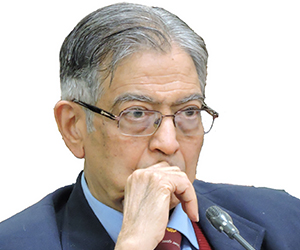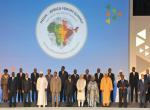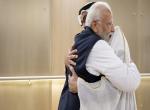Indian foreign policy under the Modi government has been characterised by unparalleled energy, informed by great vision and maturity, and infused by a refreshing firmness. It has, above all, been guided by a non-hegemonistic approach firmly rooted in its civilizational values which, perceiving the world as one family, have impelled India to promote wellbeing wherever it can without seeking any quid pro quo. India’s SAARC neighbours have naturally been the prime beneficiaries of this approach particularly as the Modi dispensation laid a special emphasis on furthering ties with them and on helping them achieve their developmental goals.
The special importance attached by India to its SAARC neighbours by the Modi government was reflected in the invite extended to their leaders for Prime Minister Modi’s inauguration way back in 2014. Such a move was unprecedented and had never been taken by any of his predecessors. In so doing he was highlighting that the region was of immense importance to India and that the destinies of all the countries within it were intertwined. Fittingly, the first foreign country visited by Modi after assuming office was from within the region and amongst the smallest notably Bhutan. Soon, thereafter, he announced that India would launch a satellite dedicated for the welfare of countries within the region. This was duly done in 2017. The satellite provides information on tele-medicine, tele-education, banking and television broadcasting opportunities. It is also equipped with state-of-the-art remote sensing technology which enables collection of real-time weather data and helps in geological observations. All South Asian countries barring Pakistan, which refused to participate, are beneficiaries of the satellite.
The Modi government recognized, ab initio, that in order to overcome the trust deficit and sense of neglect of its smaller neighbours it was important to have frequent high-level exchanges. Accordingly, displaying phenomenal energy, the Modi government overcame this shortcoming in quick time. In this process, the Prime Minister himself set a scorching pace and over the last decade met his counterparts from each of these countries on multiple occasions: sometimes in India, sometimes in their own capitals, and sometimes on the sidelines of multilateral fora. As cited by the Annual Report of the Ministry of External Affairs for 2022 the Prime Ministers of India and Bangladesh met as many as 15 times since 2015. There were also a similar number of exchanges since May 2014 between the head of state or government of Nepal and that of India. Prime Minister Modi himself personally visited Nepal as many as five times, Sri Lanka and Bhutan thrice each, Bangladesh and Afghanistan twice each, and Pakistan and the Maldives once each. The magnitude of change that this represents from earlier times is borne out by the fact that Prime Minister Modi was the first Indian Prime Minister to visit Sri Lanka in 2017 after a gap of 28 years, and the first Indian Prime Minister to visit Nepal in 2014 after a gap of 17 years. [1] Such high-level exchanges have played an important role in furthering India’s linkages with its South Asian neighbours and greatly alleviating the sense of neglect harboured by them vis a vis India.
In keeping with India’s non-hegemonistic ethos and anxious to be a problem solver rather than a problem creator, the Modi government in July 2014 readily accepted the award of the Permanent Court of Arbitration relating to the Bay of Bengal maritime boundary dispute between India and Bangladesh even though the latter was awarded the lion’s share of the disputed area getting as much as 19467 sq. km out of the total area of 25602 sq. km. [2] Indeed, India’s approach stands out in marked contrast to that taken by China which rejected the arbitral award given by the Permanent Court of Arbitration which went against it in its dispute with the Philippines. Furthermore, in 2015 the Modi government went on to ink the historic land boundary agreement with Bangladesh whereunder all differences relating to the 4096 km border with Bangladesh---- India’s longest with any country----were settled. This unsettled border was a hangover from partition and had hitherto defied resolution creating much bitterness between the two countries. It may be mentioned that the settlement of this issue was complicated by the fact that there were as many as 55 Bangladeshi enclaves in India and 111 Indian enclaves in Bangladesh in addition to numerous pieces of land in adverse possession of each other. This landmark agreement not only smoothened out the border between the two countries but also gave a boost to the bilateral relationship. Indeed, Prime Minister Modi in an interview on the eve of his visit to Bangladesh in 2015 likened it to the fall of the Berlin Wall. [3]
While India, as guided by its traditional ethos and values, always tried to help those in distress, under the Modi dispensation the size and scale of India’s role in this regard has been greatly upgraded. This has, of late, been most in evidence, with India engaging in innumerable rescue missions in the Gulf of Aden and the Western Arabian Sea in support of shipping under terrorist attack. It was also apparent during the Covid epidemic when India supplied vaccines and pharmaceutical products to over one hundred countries including, of course, many of its South Asian neighbours. Two of the most notable instances of Indian assistance during the last 10 years relate to the horrific earthquake of April 25 2015 in Nepal and the catastrophic financial crisis of 2022 in Sri Lanka.
It is estimated that as many as 9000 people were killed and lakhs were injured in the Nepal earthquake. In addition, there was massive damage to infrastructure resulting in economic losses amounting to $7.4 billion. India reached out to the victims even before Nepal’s state machinery could do so with its rescue teams reaching Kathmandu within six hours of the earthquake. While these rescue missions reduced the sufferings of the affected including both Nepalese and foreign nationals, India pledged as much as $1 billion for reconstruction work in Nepal. [4]
If the speed and scale of India’s help in regard to the earthquake in Nepal was monumental, it was more than matched by that in regard to the Sri Lankan financial crisis of 2022 as a result of which the country was in an economic meltdown. Its foreign exchange reserves were down to about $1.6 billion while debt repayments due were of the order of around $6.9 billion. [5] Inflation was running at around 50% and there were incessant power outages as well as widespread shortages of all manner of essentials ranging from fuel to pharmaceuticals. It was in these circumstances, that India came to Sri Lanka’s help with a comprehensive bale out package of about $4 billion designed to enable it to address both its financial difficulties and critical material shortages becoming in the process a lender of last resort for it as neither China nor the IMF stepped into the breach early enough to afford Sri Lanka the help it needed so urgently. India, additionally, went on to successfully plead Sri Lanka’s case with other likeminded countries to influence the IMF to help out Sri Lanka.
The Modi government has continued and indeed built upon the tradition of providing economic assistance to many countries with a focus on its SAARC neighbours under three chapeaux, notably outright grants, lines of credit on concessional terms and training slots. The magnitude of such Indian support is considerable. For instance, in the case of Bangladesh in the last 8 years alone India has provided 4 lines of credit amounting to about $8 billion for multifaceted infrastructure development. Additionally, it receives as many as 800 training slots annually under India’s ITEC programme. Similar generosity has also been extended to Bhutan which received grants amounting to Rs 9000 crores for its five-year plans from 2013 to 2023 from India which was the extent of the total plan assistance provided to it by the latter since 1961. [6] Additionally, as many as 300 training slots are earmarked for it annually under India’s ITEC programme and for the current five-year plan India has just promised assistance amounting to Rs 10,000 crores.
A major focus of India’s economic cooperation programmes with its SAARC neighbours has been the development of multifaceted connectivity ranging from roads and railway lines to power transmission lines and petroleum pipelines. The results have been significant and brought India much closer to its neighbours. In Nepal, for instance, recent years have witnessed the completion of as many as 14 Terai Road packages connecting its 1000 Km long East West Highway to the Terai region bordering India, a cross border petroleum product pipeline extending from Motihari in India to Amlekhgunj in Nepal, 3 cross border power transmission lines, operationalisation of the 38 Km Jayanagar-Kurtha broad gauge rail link, and construction of several river bridges most notably the 6 lane bridge over the river Mechi connecting Kakabhitta in Nepal to Panitanki in West Bengal as a part of Asian Highway 2. In the case of Bangladesh progress has been even more spectacular. Five of the six pre-1965 rail links have been revived as a result of which there are now 3 passenger trains plying between India and Bangladesh and rail freight traffic between the two has seen a 130% year on year growth. Five bus services are operational between India and Bangladesh and arrangements are in place for river-borne transit and cross-border traffic. In order to ensure smooth operation of the latter, joint dredging is being undertaken on the Brahmaputra and Kushiyara rivers. Power transmission lines have been put in place for export to Bangladesh of 1160 MW of power and an India-Bangladesh Friendship pipeline has been built for export of high-speed diesel to Bangladesh. Better connectivity between the North East and Bangladesh has been sought to be promoted in the mutual interest inter alia by the development of a rail link between Akhaura and Agartala and the operationalisation of an agreement to open up Chattogram and Mongla ports for use by the former.
While India has historically enjoyed excellent ties with both Afghanistan and Maldives and had vibrant development cooperation programmes with them, regime change in both has, inevitably, led to a downturn in its relationship with them. The Modi government has, however, shown commendable maturity in handling the adverse situation thrust on it by the changed circumstances keeping in mind India’s long standing friendly ties with these countries, the fact that it enjoys much support there at the popular level, and that a turnaround in the situation over time is always possible. In the case of Afghanistan, while the advent of the Taliban government there in 2021 left India little choice but to close down its Embassy in Kabul, it not only kept a line open to the new regime but provided much humanitarian assistance out of concern for the friendly people of Afghanistan. In this context it, inter alia, provided 40000 tons of wheat, 55 tons of medicines, winter clothing and half a million doses of Covid vaccine. Furthermore, following the 2022 earthquake, it supplied 28 tons of emergency relief assistance. The continued outreach to Afghanistan has been facilitated by the fact that the new dispensation there, living up to its assurances, has refrained from involving itself in terrorist activity directed against India. Similarly, the advent to office of President Muizzu in November 2023 in the Maldives and his openly anti-Indian and highly provocative moves have not induced any knee-jerk retaliatory actions from India. On the contrary, knowing that it has much support in the Maldives, India has displayed exemplary patience, sought to maintain its considerable links in that country, negotiated its differences with the local leadership, and continued its economic assistance programs.
Finally, in regard to Pakistan, an already bad relationship has worsened. This has happened despite Prime Minister Modi’s personal outreach to the Pakistani leadership as evidenced by his invite to Nawaz Sharif for his inauguration in 2014 and by his impromptu visit to Pakistan in December 2015. Yet these moves were responded to by Pakistan by the continued export of terror to India as most vividly evidenced by the Uri terror strike in 2016 and the Pulwama attack in 2019. It is a measure of India’s firmness that it did not take these Pakistani actions lying down as had been the practice earlier and, instead, responded to the former by the cross LoC surgical strikes and to the latter by the cross- international border Balakot air strike. It further resolved that business as usual between the two countries could not possibly continue until and unless Pakistan eschewed the use of terror against India. Had such firmness been shown by earlier Indian dispensations it would, perhaps, have helped in tempering Pakistan’s propensity to resort to terrorist actions against India.
References
[1] “The Modi Doctrine” edited by Anirban Ganguly, Vijai Chauthaiwala and UK Sinha published in 2016 by Wisdom Tree.
[2] India’s Relations with its SAARC Neighbours” by Satish Chandra published by VIF in 2019
[3] “The Modi Doctrine” edited by Anirban Ganguly, Vijai Chauthaiwala and UK Sinha published in 2016 by Wisdom Tree.
[4] ibid
[5] “India as a lender of last resort” by Thilina Panduwawa datelined 4 July 2023 from the Diplomat accessed at 2.30 PM on 10 March 2024 from https://thediplomat.com/2023/07/india-as-a-lender-of-last-resort/
[6] Derived from data contained in the paper titled“The Changing Contours of Bhutan’s Foreign Policy and the Implications for China and India” by Aditya Gowdara Shivamurthy published by the ORF on 21 July 2023 accessed on 15 March 2024 at 3.30pm from https://www.orfonline.org/research/the-changing-contours-of-bhutan-s-foreign-policy-and-the-implications-for-china-and-india
(The paper is the author’s individual scholastic articulation. The author certifies that the article/paper is original in content, unpublished and it has not been submitted for publication/web upload elsewhere, and that the facts and figures quoted are duly referenced, as needed, and are believed to be correct). (The paper does not necessarily represent the organisational stance... More >>
Image Source: https://www.manoramayearbook.in/content/dam/yearbook/learn/world/images/2023/jan/saarc.jp





.jpeg)




Post new comment